Abstract
Textile-reinforced concrete (TRC) is a form of reinforced concrete, where conventional reinforcement is replaced with textiles or fibers. The high tenacity of the textile fibers results in flexible and durable concrete structures. The literature has been limited to TRC applications in retrofitting and nonstructural applications. Therefore, this article attempts to detangle the progressive research direction on the usage of TRC as a structural member. For this, (i) a bibliometric study using scientometrics analysis to visualize the keyword network, and (ii) qualitative discussions on identified research areas were performed. The literature was categorized into four main research areas, namely material properties of TRC, composite behavior of TRC, bond-slip relations, and TRC applications as structural elements. In addition, the advantages and disadvantages in the usage of TRC as a structural member are discussed in association with the identified research areas. Furthermore, the article proposes future directions to reinforce the research on the usage of TRC as a structural element.
1. Introduction
The advancement in construction materials and technology has led to research into efficient and sustainable structural systems that incorporate the properties of minimum material usage, light weight, and added economic benefits. To attain this, researchers impregnated a certain number of fibers into the concrete matrix as they are effective in reducing cracks and can improve the ductility behavior of concrete [1] by making the sections more compact, which can ultimately lead to more economic designs [2]. The alternative method is to replace the steel reinforcement with textile (fiber) mesh, creating textile-reinforced concrete (TRC). The nonmetallic nature of TRC eliminates the usage of concrete cover, resulting in slender members.
Textile-based composites have been studied extensively in the past two decades as they are used in the construction of newly fabricated structural elements (e.g., [3,4]) and the strengthening of existing structures (e.g., [5,6]). TRC possesses enhanced properties such as increased flexibility and resistance to fire. Therefore, TRC is becoming progressively more attractive for strengthening existing structures, in comparison to the more extensively used fiber-reinforced polymer (FRP).
Numerous studies have been conducted globally to assess the suitability of TRC as a building material, in terms of its tensile and flexural strengths [7,8,9]. Typically, the specimen is prepared in the form of plates and is subjected to either tensile or three-point bending tests. The results are highly dependent on the type of fiber and the mix design of concrete used. In terms of the bond strength, the majority of researchers have attempted to quantify the bond strength of externally bonded fiber [10,11], as TRC is used as a repair material. In textile-reinforced concrete, as the fiber is embedded within the concrete matrix, a new and better bond strength model must be established specifically for this application. This is important for the correct prediction and modeling of the behavior of TRC using numerical analysis. Thus, a comprehensive review of TRC would be useful to provide a holistic picture and allow a wider application of this material in the future.
The novelty of this article is that it applied the science mapping approach (SMA) in the research domain of TRC by using a bibliometric search and scientometrics analysis to reduce the biases [12]. In addition, the current article is further extended with an in-depth qualitative discussion by assessing the existing research on TRC with the following research objectives: to determine (a) the material properties of TRC, (b) the composite behavior of TRC, (c) the bond-slip relations, and (d) the applications of TRC as structural elements. This is followed by a discussion of the recommendations for future research.
2. Bibliometric Literature Search
The present article adopted a comprehensive approach [13] for evaluating the recent research outputs in the field of TRC from 2010 to 2022 (February) published in Scopus. The research framework illustrated in Figure 1 consists of three sections, namely (i) literature retrieval, (ii) scientometrics analysis, and (iii) qualitative analysis through specific research areas. The literature is divided into four research areas: (A) the material properties of TRC, (B) the composite behavior of TRC, (C) the bond-slip relations, and (D) the applications of TRC as structural elements. This is based on the common theme found in the literature review conducted.

Figure 1.
Workflow for reviewing the literature on TRC.
2.1. Literature Retrieval
The literature retrieval on TRC articles was performed using Scopus, which is considered the major search engine for academic publications. The literature search was performed by entering the following keywords in Scopus: TITLE-ABS-KEY (“textile reinforced concrete, TRC, textile fibers, and textile shells”). The keywords search identified relevant articles published from 2010 to 2022 (February). As shown in Figure 1, a total of three substeps were performed to screen-out articles that were out of scope and did not focus on TRC.
2.2. Scientometric Analysis on Keywords and Publication Sources
The text-mining tool (VOS Viewer), developed by [14], was adopted in the current article for the enhanced analysis and visualization of the bibliometric studies. This study utilized VOS Viewer to achieve the following key objectives: (i) to obtain the downloaded literature data from Scopus, (ii) to study the mainstream research keywords and their inter-relationships, and (iii) to visualize, compute, and analyze the publication sources and countries belonging to the TRC research community.
2.2.1. Keyword Network Analysis
The keyword-based literature search in Scopus produced 1097 articles, from which the initial screening removed any articles that were out of the TRC scope (i.e., those that included few other polymers along with TRC). The second set of screening was performed on TRC with a specific focus on engineering applications, leading to a dataset of 510 articles for review. Based on the recommendations proposed by [12,13,14,15], in the present article, “Author Keywords” and “Fractional Counting” were used in the VOS Viewer analysis.
The minimum occurrence of a keyword was set at 5. Initially, 302 out of 3263 keywords met the threshold, from which some general items were removed to reduce the effect of regular topics, e.g., “reinforced plastics”, “concrete buildings textile industry”, and “steel fibers”. Various other keywords with the same semantic meanings, such as “textile reinforced concretes” versus “textile reinforced concrete”, “bearing capacity” versus “load bearing-capacity”, “FEM” versus “finite element method”, and “mechanical properties” versus “mechanical behavior” were combined in the second-round keyword analysis. Finally, a total of 29 keywords were selected, as shown in Figure 2.
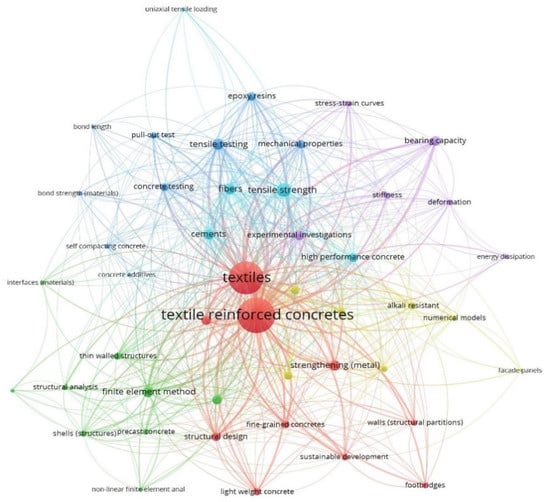
Figure 2.
Co-occurrence of keywords in TRC research.
The node sizes, distances among the nodes, and connection lines among the keywords are shown in Figure 2 and display the most frequently studied terms. The node colors were used to divide the keywords into different clusters. The font and node size visually represent the number of articles from the given journals, with larger fonts and node sizes indicating larger numbers of publications. The clusters represented by different colors and connection lines indicate the closeness among the keywords in terms of mutual citations.
2.2.2. Periodical Publications
The literature retrieval was conducted for publications from the years 2010 to 2022 (February) based on the keyword analysis. The study of TRC is a newly emerging research area, in which a significant number of publications were produced after 2010. In total, 510 publications were found within the last 11 years, with 313 coming from journals. Figure 3 illustrates the number of yearly publications on TRC and shows the increasing trend in recent years.
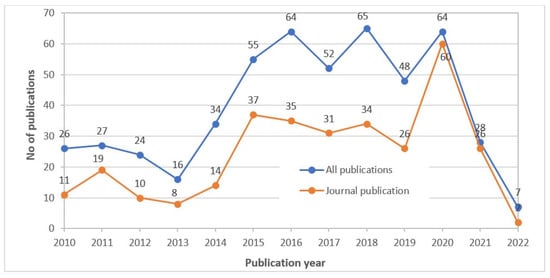
Figure 3.
Yearly publications on TRC from 2010 to 2022 (up to 20th February).
2.2.3. Research Streams of Textile-Reinforced Concrete
Based on the selected papers, the mainstream research work on TRC can be categorized in terms of (A) the material properties of TRC, (B) the composite behavior of TRC, (C) the bond-slip relations, and (D) the applications of TRC as structural elements.
Most articles on TRC fall within research areas (A) and (B), showing that studies of material properties and composite behavior are still ongoing. A significant number of articles (135) discuss the material properties of TRC (A), including the evaluation of bending and shear strength [16,17,18,19], the effect of elevated temperature and fire [20,21,22,23], freeze-thaw cycles [24,25], and dry-wet cycles [24,25,26]. In addition, some publications detail the self-sensing ability of the carbon fiber embedded in the concrete [27,28,29] by means of electrical resistance for structural health monitoring. In the area of the composite behavior of TRC (B), 108 articles focus on using textiles as a retrofitting material and a complementary substance in the sandwich sections. In detail, these articles discuss the mechanical behavior of structural elements strengthened with TRC [30], sandwich composite faces [31,32,33], the dynamic and fatigue responses of composites [34,35], and the prestressing behavior of TRC beams [36]. The studies on TRC further focus on bond-slip relations (26 articles) and application as a structural element (44 articles). In the aspect of research on bond-slip relations (C), most articles explain the bond behavior [37,38], pull-out response of fibers [18,39], and interface relations through numerical and experimental methods [40,41,42]. Articles related to TRC applications (D) address the evolution, fabrication, and design of TRC as structural elements such as shells [43,44,45], facade panels [33,46,47], and bridges [3,48].
The research papers on TRC have been published in 84 different journals. Figure 4 shows the 14 main journals that published at least five articles on TRC. As shown, the leading two journals in this area are Beton- und Stahlbetonbau and Construction and Building Materials. The main themes in these publications are the material properties of TRC (A) followed by the composite behavior of TRC (B).
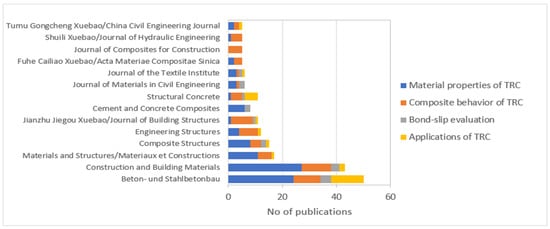
Figure 4.
Main journals in TRC.
2.2.4. Countries Focusing on Textile-Reinforced Concrete
Figure 5 shows the distribution of TRC-based publications according to countries. The two countries leading the research in this area are China and Germany, accounting for approximately 60% of the total publications. The large number of publications in these countries reflect their focus on using sustainable materials and technology. In countries such as China and France, 75% of their research is conducted on the use of TRC in retrofitting technology (e.g., strengthening columns or beams). Germany is the most advanced country in terms of using TRC as a reinforcing material (e.g., application as sandwich facades, shells, and bridges). In regard to international collaborations, researchers from Germany have collaborated widely with those from other countries, such as Israel, Sweden, and Austria. However, other countries are still in the early stages of adopting TRC technology; hence, the research is limited to the determination of material behavior rather than its applications.
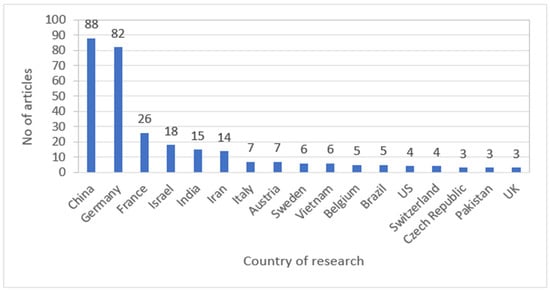
Figure 5.
Distribution of publications according to country.
For this analysis, the minimum number of both documents and citations for a country was set at 5. This resulted in a total of 20 out of 40 countries that met the threshold. In Figure 6, the network lines indicate the citations of TRC research undertaken jointly between different countries. According to the size of the regional nodes and the density of the connecting lines, the China, Germany, USA, Canada, and Israel regions were found to be the most active in collaborating with other regions, despite the number of publications.

Figure 6.
Science mapping of active countries in TRC.
3. Discussions on TRC Research Areas
3.1. Material Properties of TRC
TRC is a composite structure, which consists of the textile fiber and the concrete matrix. The typical properties of the concrete and the textile embedded in it are discussed in the following sections.
3.1.1. Textile Fiber
Steel has traditionally been used as a reinforcing material in concrete due to its high tensile strength and ductile behavior. However, steel is often associated with high carbon emissions during production and higher cost due to the depletion of natural resources. Moreover, steel requires sufficient concrete cover for corrosion protection, causing larger sections in an otherwise slender member. Possible substitutions for steel as reinforcement have been explored and the usage of textile reinforcement has been proposed by many researchers.
Fiber, yarn, and fabric are various forms of reinforcement that have been used as reinforced fiber composites. Textile reinforcements were initially used in the form of chopped and short fibers. The use of mesh or continuous reinforcement has been explored over the past two decades because of its flexibility and ability to be fabricated into complex shapes [49]. Fibers can be classified into two types, natural and man-made fibers. The main sources of natural textile fibers are animals, plants, and natural minerals, whereas synthetic materials and ceramics fabricated using mineral fibers are considered as man-made [50]. Natural fibers made of animal products are not applicable in the construction field, while plant-produced fibers could be used to some extent by having them chemically treated. The most suitable and commonly used fibers in engineering structures are synthetic fibers because of their enhanced mechanical properties and stable nature. Different fibers are listed in Table 1, along with their mechanical properties. As shown, manmade fibers typically have higher tensile strength and elastic modulus compared to natural fibers, making them preferable for use in structural applications.

Table 1.
Types of fiber and its mechanical properties.
A set of combined fibers interlocked and used for sewing, weaving, or knitting is called yarn. A single yarn (filament) typically has a diameter of 5–30 µm and, when combined in thousands, is called roving. The major issue with using textiles directly as reinforcement is their poor bonding in concrete. To improve the bonding of yarns in concrete, three manufacturing techniques have been developed: cabled, friction-spun, and commingled yarns [55].
Fabric is a combination of a group of yarns. They are classified based on the manufacturing procedure, namely woven, nonwoven, and knitted. Woven fabrics are produced by weaving a set of yarns interlaced perpendicularly. The yarns that run along the length of the fabric are known as warp yarns, while those on the other side are called weft yarns. For construction applications, leno-type fabrics are used, whereby two sets of warp yarns are twisted around the weft yarn to form a grid-like structure [49]. It is common to find textile fabrics woven in the form of a mesh, with specific mesh sizes in the warp and weft directions. The presence of a mesh increases the bond between the concrete and the textile, thus increasing the overall structural strength. Mesh sizes between 5/5 and 10/10 mm (warp/weft directions) are commonly used in structural applications (for example, [9,24,39,46]).
Three types of materials are mainly used as textile reinforcement, namely carbon, AR glass, and basalt. Carbon textile is abundantly used in TRC. The properties explaining its frequent usage include its high ductility, tensile strength (1100–4000 MPa), and Young’s modulus (150–235 GPa). Commonly used mesh sizes are 5/5–8/8 mm (warp/weft directions). This material is widely used in shells, slabs, and most structural applications. The next most widely used fiber in TRC is AR glass textile. It has a tensile strength of 120–790 MPa and a Young’s Modulus of 30–40 GPa, and it is less ductile than carbon fiber. Commonly used mesh sizes are 5/5–10/10 mm. Based on the mechanical properties, this material is limited to secondary structural applications such as facade panels, formwork, and non-load-bearing partition walls. The fiber least commonly used in TRC is basalt. This material is always used with coated resins because of its low mechanical properties in comparison with the other available fibers. The tensile strength of basalt (with coating) ranges from 490 to 890 MPa and its Young’s Modulus ranges from 28 to 45 GPa. Commonly used mesh sizes are 5/5–25/25 mm. This material is one of the more sustainable alternatives and is used in riverbanks (bunds) and nonstructural elements.
A comparison of the stress-strain relationship of steel and carbon textile mesh reinforcements is shown in Figure 7 [56]. Steel reinforcement yields at a stress of fs,y corresponding to the strain of εs,y (approximately 0.3%). Upon yielding, the steel undergoes significant ductility until it fails at the ultimate stress and strain of fs,u and εs,lim, respectively. In comparison, carbon textile reinforcement has a lower initial stiffness compared to steel, up to the strain of εt,1. An increase in stiffness occurs beyond εt,1 as the yarns elongate. Brittle failure occurs once the ultimate limit strain εt,lim has been reached, which prevents the widespread use of textile reinforcement.
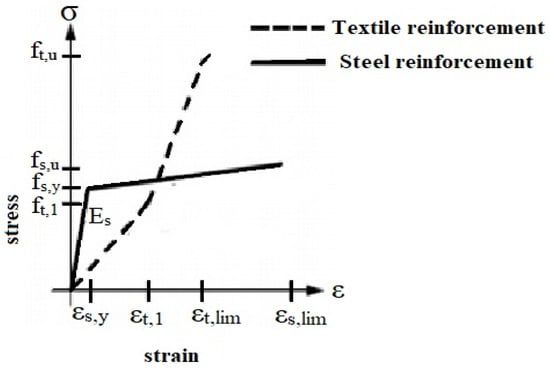
Figure 7.
Tensile behavior of steel and carbon textile reinforcements [56].
3.1.2. Coatings
When filaments are bundled, microscopic gaps are formed between the fibers that cannot be penetrated by the cement matrix, causing a nonhomogeneous textile-cement composite. Due to this, only the outer end filaments will be strained, resulting in the straining of only 35% of the roving capacity [48]. To overcome these effects, the textiles are coated to stabilize the inner structure of the filaments, ultimately increasing their tensile strength. By coating the textile reinforcement, the load can be transferred more homogeneously among the filaments that enhance the load-bearing capacity, producing a smoother response to loads [49].
Coatings such as epoxy resin or styrene-butadiene have shown encouraging results in terms of tensile stress and maximum ultimate strain. Epoxy resin is generally used for planar members or molded reinforcements such as facades [47] and web reinforcement for T-beam bridges [57]. Meanwhile, rolled-up sections such as temporary reinforcements used for renovations are produced using styrene-butadiene as the fiber coating. Experimental work was carried out by [48] to compare the effect of coatings (epoxy resin and styrene-butadiene) on two different fiber materials, namely AR-glass and carbon, in terms of the load-carrying capacity and stress-strain behavior. The results showed that the fibers coated with epoxy resin achieved considerably higher tensile strength compared to those coated with styrene-butadiene (Figure 8). Researchers have coated the textile surface with sand to increase the bond strength and ultimately increase the bearing strength of the element [24,58].
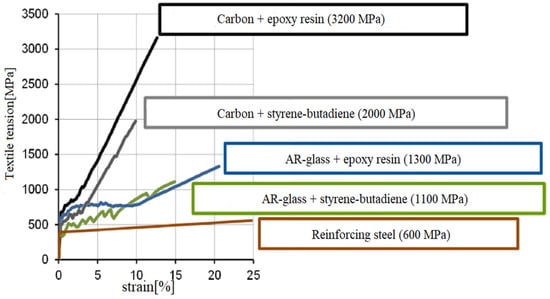
Figure 8.
Comparison of different textiles and coatings under tensile stress [48].
Based on the extensive literature review, carbon fiber mesh with an epoxy coating is the most common type of fiber reinforcement used for structural applications due to its high tensile strength. AR glass with a coating is also widely used in non-load-bearing structural elements as it is cost-effective and shows good bonding behavior with concrete.
3.1.3. Cement Matrix
The cement matrix for TRC comprises binders, fine-grained aggregates, and a low water-to-binder ratio. The matrix has to be designed to be physically and chemically compatible with textile reinforcement. When choosing the binding material, the main parameters are (i) its high strength, based on the application, (ii) a sufficient bond between the reinforcement and cement matrix, (iii) its workability during fabrication and setting, (iv) its geometrical stability [59], (v) the production process [60], and (vi) low shrinkage and creep [61]. The rheological properties of concrete (incorporated with textile reinforcement) are enhanced by various compositions of the cement-based matrix. The most frequently used binder content for TRC is 40–50%, with a water-to-binder ratio ranging from 0.29 to 0.40. An increase in binder content improves the bonding of mortar with reinforcement. The grain size ranges from 1 to 2 mm, depending on the mesh size of the reinforcement used.
The addition of pozzolans in the cement matrix increases its alkalinity. However, there are no concerns in maintaining the pH balance as the textile used in TRC is alkali-resistant [49]. The mineral admixtures often used in TRC include fly ash, micro silica, and metakaolin. Due to their small particle size and highly pozzolanic reactivity, these materials improve the bonding and mechanical performances. Durability is ultimately improved due to their lower permeability. A substantial replacement of cement with fly ash increases the dicalcium silicate (C2S) content, which leads to an increase in carbonation.
The hardened concrete properties are assessed based on mechanical behavior during compression and tension. The typical application of TRC demands special concrete that is more durable, more ductile, and stronger than normal concrete. Based on the literature, the typical compressive strength used in the cement matrix is 50–60 MPa for structural applications (for example, [9,18,62,63]). A higher strength of 120 MPa has also been used for filigree construction and bearing applications in architecture [64].
3.1.4. Cost Analysis
Similar to conventional reinforced concrete, the production cost of TRC-fabricated elements depends on the fiber used, the type of structural application, and the labor costs. For instance, if a structure is designed to resist major chemical attacks, then high-strength fiber (with high-cost carbon) should be selected as reinforcement. In addition, polymer-based coatings are also applied, which increase the overall cost. For normal applications such as shells and facades, low-cost textiles (basalt or glass fibers) can be used [65].
The concrete cost will also vary depending on the type of structural application. For instance, when constructing a traditional reinforced concrete flat slab, grade 30 concrete is used (fck = 30 N/mm2). If TRC is used instead, a self-compacting concrete of grade 45 (fck = 45 N/mm2) is required to avoid vibration during material placing. Even though TRC requires higher concrete strength, a slender section can be designed that reduces the overall material cost compared to that of conventional concrete. In addition, the concrete used for TRC possesses high workability, which reduces the labor cost, based on the simplified placement of textile mats and the ease of concrete casting when self-compacting concrete is used. Moreover, the time-dependent costs, such as those of equipment and scaffolding, can be minimized using TRC [66].
3.2. Composite Behavior of TRC
As the TRC is to be applied as a structural member, the mechanical properties of the material must be studied to ensure they are behaving as a composite member. TRC has been tested for its tensile and flexural behaviors as a composite and in the shape of a sandwich element.
3.2.1. Tensile Behavior
To assess the tensile behavior of TRC, uniaxial tensile tests have been performed using a static hydraulic testing machine at a constant rate of displacement [67]. To date, there is no specific handbook on the testing procedure and shape of the specimen. The general rectangular-shaped specimen shown in Figure 9 is clamped onto the test setup using steel fixtures, which act as mediator for tensile load application. The specimen is divided into three zones: loading, transition, and testing. LVDTs are fixed at the center to assess the tensile strain at a certain gauge length, while the load is applied at a constant rate until failure. A standard test method of determining the tensile strength is recommended to assess the stress-strain curve for the design of the TRC element [68,69]. The tensile test is carried out in a controlled mode by crosshead displacement at a strain rate of 2 milli-strain per min. The major findings from this test setup include the stress-strain relation, crack pattern, type of failure, and maximum stress of the cross-sectional area.
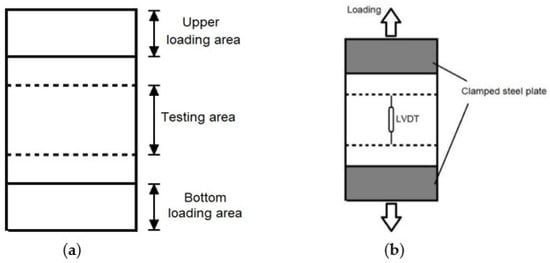
Figure 9.
(a) Typical geometry and (b) test setup for tensile test of TRC specimen adopted from [68].
Other test setups and procedures to evaluate the properties of TRC were summarized by [70]. It has been found that different test setups for bond strength have yielded varying results, which shows the importance of considering the anchorage length in such tests. For example, dumbbell-shaped specimens were proposed by [71] to avoid failure at the specimen ends. The research by [72] discovered that the increase in textile layers at the end anchorage zones will improve the load distribution.
The failure pattern of TRC has been classified into three states, as shown in Figure 10, based on the study by [40]. In the first state, the TRC sample shows similar properties to those of reinforced concrete without cracking, and the curve is linear. After the first crack (fcr) occurs, the sample passes into the second state (II), in which multiple cracks form. As a result, an almost horizontal plateau develops in the stress-strain curve due to the low stiffness. When the sample reaches the ultimate load (state III), brittle tensile failure in textile-reinforced concrete is observed. The deficiency in anchorage length could lead to pull-out, resulting in premature failure before the ultimate load has been reached.
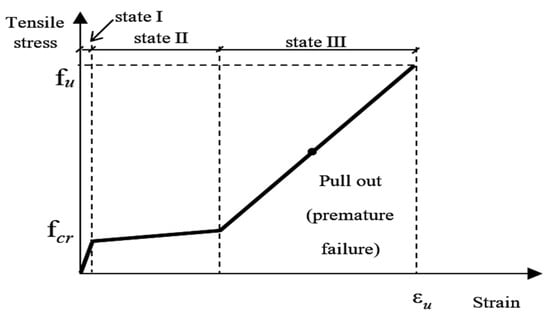
Figure 10.
Typical stress-strain relationship of TRC [40].
To explain the tensile behavior of TRC at the microscopic level, [73] developed a probabilistic approach. The tensile response is observed at three levels, namely the filament, crack bridge, and direct tensile tests. By combining these levels as a single model, the tensile and bond behaviors based on the stress distributions of TRC can be determined.
3.2.2. Flexural Behavior
Most TRC applications are geared toward tension members, whereas in members such as shells and facades, failures have been observed in bending. Based on the literature review, the flexural strength of the TRC elements has been determined through test setups similar to those used for normal structural panels, slabs, and beams under three-point and four-point loadings. Due to the far thinner nature of TRC, it could sustain a smaller flexural load, while care must be taken to ensure the failure mechanism could be observed and monitored appropriately.
To assess the bending capacity of the TRC elements, researchers have tested TRC plates and slabs [61], sandwich panels [74,75,76,77], and I-beams [69] under bending tests (Figure 11). In a number of these tests, the effects of parameters such as the type of textile and the number of textile layers on the bending capacity were investigated. Similar to the tensile test, the usage of carbon fiber yields high flexural strength and ductility, while the energy absorbed by TRC increases with the number of textile layers. In addition, [78] reported that the bending capacity of TRC can further be increased by pre-stressing the textiles. The study proves that by pre-stressing the textile, the first-crack load capacity increased by 85% compared to that of the conventional placing.
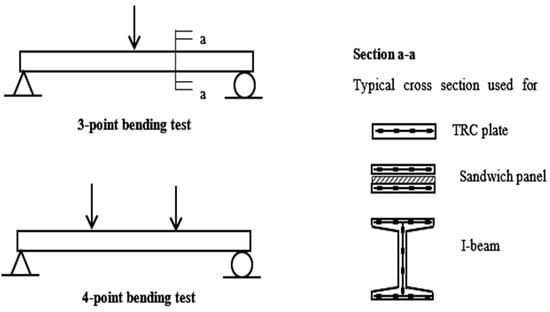
Figure 11.
Bending test on a typical cross-section of TRC element.
3.3. Bond-Slip Relations
When elements are fabricated as TRC, either the concrete or textile reinforcement tries to slip out of the matrix, depending on the load concentration, and residual stress develops because of this. Most of the literature suggests that this type of TRC failure is generally observed in the anchorage zone, as the stress concentration is extensive at that location [79,80]. The bond in TRC is primarily dependent on the properties of the textile (material and geometry) and cement-based matrix (concrete strength), which also influence the strength, ductility, and behavior of the composite.
Quantifying the bond-strength relationship is important as a strong bond between the fiber and the concrete matrix leads to an increase in the overall composite strength and ductility. Weak bonding, on the other hand, causes premature failure in terms of fiber pullout. To enhance the strength and toughness of the TRC composite, fibers with high strength and elastic modulus are utilized. Many experimental and analytical investigations have been performed to characterize the bond between the fiber and the cement-based matrix [18,41,42,81,82].
3.3.1. Experimental Method
Determining the bond strength of TRC is usually performed through experimental testing of TRC plates under tensile force. Generally, the bond-slip of rebar within the concrete is determined by a direct pullout test, based on the RILEM (Reunion Internationale des Laboratoires et Experts des Materiaux) recommendation [68] and ASTM 234-91. For TRC, the conventional bond length setup cannot be used, due to the small fiber diameter (less than 2 mm). Banholzer [60] adopted a similar technique to the pullout test of steel reinforcement to find the slip rate of the textile (Figure 12a). For testing, one end of the fiber was embedded in concrete (50 mm) and the opposite end was embedded in an epoxy resin block (30 mm). The results obtained on a single yarn were unable to satisfy the actual bond-slip behavior, due to premature failure, where strand yielding occurred before the ultimate load was reached. To overcome this, [83] developed a double-sided notched plate by performing a pullout test on the textile to introduce direct force on the yarn embedded in concrete. The bond length (tested) and anchorage lengths were 20 mm and 100 mm, respectively (Figure 12b). According to [84], when using uncoated textiles, an anchorage length of more than 100 mm is recommended to overcome yarn crack.
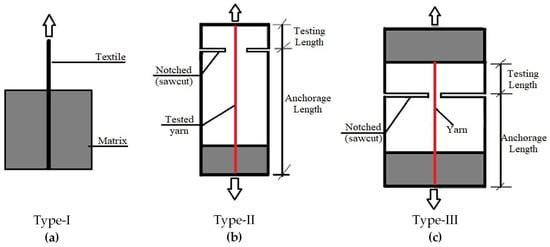
Figure 12.
Pullout test setups for bond-slip (a) direct pullout (b) double-sided unsymmetric and (c) double-sided symmetric.
In the earlier tests, the effect of anchorage length has not been emphasized, leading to unreliable results in these studies. To overcome this, [17,36] tested TRC with different anchorage lengths and discovered that the maximum force and the deformation increased with a longer anchorage length. The pullout test estimated the slip development while ignoring the effect of the transverse yarn. The details of different pullout tests are listed in Table 2, whereas the types of testing are referred to in Figure 12.

Table 2.
Different specifications of pull-out test specimens.
Other test methods have been developed, for example, one-sided and two-sided pull-out tests [38,88], to determine the pull-out force-slip curve of TRC specimens. In any pull-out test, the setup should ensure that no eccentricity is introduced, due to sample misalignment. From the literature, a minimum anchorage length of 100–125 mm is recommended to ensure the adequate development of the stress in the member. The minimum thickness of the testing plate should be not less than 6 mm and the rate of loading is recommended as 1 mm/min.
3.3.2. Analytical Models
Analytical models for the evaluation of the bond-slip relation have been developed by [41,42,82], and these have been compared with the experimental work. The relationship between the applied load and the failure process of the strand has been evaluated analytically, based on the load-displacement and the active filament-displacement relations.
Carozzi [41] developed the tri-linear relation of the bond-slip (Figure 13) using the compatibility equation of the yarn. This expression accounts for the shear stress distribution at various loading stages and includes effects such as friction phenomena. In stage I, the yarn is bonded to the matrix, so the shear stress at the yarn-matrix interfacial zone increases proportionally to the yarn displacement, with a maximum slip of umax. As the shear stress attains the maximum limit, softening stage II begins and the stress decreases proportionally to the yarn displacement until the slip reaches u0. In stage III, the shear stress becomes constant and is equal to friction τ0, as shown in the figure. This relationship has been found to be in good agreement with the experimental work, based on different boundary conditions.
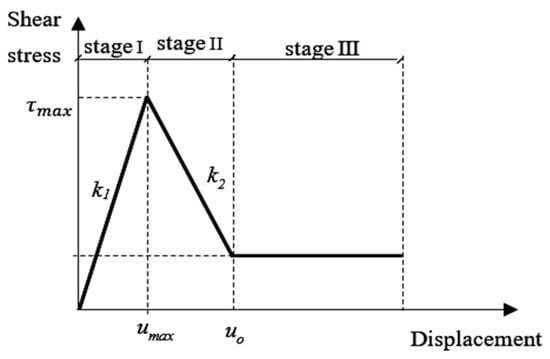
Figure 13.
Shear stress-displacement relationship at the matrix-textile interface [41].
The tri-linear stress-strain relation for TRC was addressed and modified by [82], based on the experimental data from [84], to better explain the debonding process in the TRC member (Figure 14). The relationship was developed through an inverse approach using finite element analysis. A nonlinear structural model based on the vibrational principle of potential energy and the compatibility relation was developed by [81]. The structural responses were evaluated numerically for the uniaxial loading with varying boundary conditions, using the constitutive and compatibility relations of the fiber and concrete. This model was found to be applicable under various testing conditions such as tensile uniaxial loading tests, as well as one-sided and two-sided pull-out tests. Based on the analytical and numerical relationships developed for the bond-slip, the effect of parameters such as anchorage length, material, and concrete properties could be easily investigated.
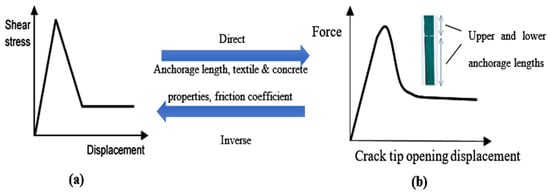
Figure 14.
Inverse approach for the determination of bond-slip. (a) Shear stress vs. slip at interface. (b) Force vs. crack opening [82].
3.4. Applications of TRC as Structural Members
The applications of TRC are mainly in thin and flexible structures such as sandwich panels [62,89], domes [90,91,92], barrel vault shells [93], and hypar roof structures [94]. Other researchers proposed more interesting uses, such as a sandwich beam [95] and a load-bearing pedestrian bridge [44]. The possible applications of TRC as load-bearing structural components are numerous. However, more research is needed in the numerical modeling of this material, as different failure modes could be obtained if different modeling approaches are used [82].
In facades and exterior cladding, TRC walls are made to be non-load-bearing (axially); however, they are designed for the out-of-plane wind loading. Depending on the applications, the walls are very slender, with a thickness of around 20 to 50 mm [48,49]. To connect between the outer TRC panels and the insulation core, proper connectors must be designed to ensure efficient shear transfer between the wythes. A detailed analytical method to identify the load-deflection behavior of TRC sandwich panels in bending was developed by [96], with the aim of enhancing the axial and flexural rigidities of the TRC facings developed by [97].
Table 3 shows the testing on sandwich panels from the available literature, whereby the bending capacity is influenced by the number of textile layers and connectors used. The most commonly used core material is polyurethane, while the fibers used in sandwich panels are AR glass and carbon fiber coated with resins and with a maximum mesh size of 10 mm. The external thickness of TRC is usually similar for the top and bottom panels, to ensure symmetrical bending behavior. Due to the non-load-bearing nature of this element, a lower concrete strength (25 to 35 MPa) will be sufficient for its application. However, a higher concrete strength will yield higher bending capacity and maximum displacement. As this was one of the first applications of TRC, the research on sandwich panels is vast and many experimental parametric studies have been conducted.

Table 3.
Literature on TRC as sandwich panels.
The applications of TRC in prefabrication are extensive and many prototypes have evolved such as rhombic lattice structures, shell elements, integrated formwork elements, and bridge components. A TRC bridge [3] was constructed over the Döllnitz river, with a span of 8.66 m and a width of 2.50 m, providing a path for pedestrians and cyclists. The structure consists of a 30 mm-thick shell reinforced with four layers of AR-glass textile fiber with a yarn spacing of 10.8 mm in both directions (Figure 15a). The load test conducted on this bridge revealed that the buckling and bending were within the allowable limits.
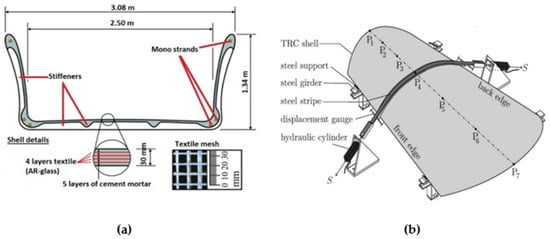
Figure 15.
Applications of TRC as structural member (a) cross-section of textile-reinforced concrete bridge [3], and (b) TRC as shell element [93].
A bicycle roof stand made of four prefabricated cylindrical vault shells (thickness of 20 mm, length of 4.40 m, and width of 2.14 m each) was constructed at RWTH Aachen University. The shells were constructed using the lamination procedure. The cross-section contained six layers of carbon fabrics with a spacing of 8.3 mm. The structural behavior of these shells was assessed using a numerical approach (the anisotropic damage model) and compared with the experimental results of [93], as shown in Figure 15b. The experimentally obtained ultimate load of a shell element weighing 4 kN was 98 kN, revealing the structural redundancy of 57% with respect to the linear ultimate limit state assessment. These tests provide valuable data for the validation of the numerical models that are suitable for carbon concrete composites with finely distributed textile fabric reinforcement.
Generally, it has been found that the traditional applications of TRC (architectural purposes, facades, and sandwich panels) did not utilize the structural capacity of the member. Attempts to use TRC as a load-bearing structure have been resisted due to the limited understanding of its behavior. With the increasing experimental and numerical works on the unconventional uses of TRC, it is hoped that this material will become widely used and accepted in codes of practice around the world.
4. Conclusions and Recommendations for Future Work
Textile-reinforced concrete (TRC) is a form of reinforced concrete, in which steel bars are replaced with textile fibers. TRC can be used in retrofitting and to create small components such as panels. Based on the existing literature, certified testing procedures and approval for TRC as a structural element are currently unavailable.
In this paper, the current trends and advances in TRC are discussed in terms of four main areas: the material properties, composite behavior, bond strength, and applications. Based on an extensive literature review, studies on TRC appear to be dominated by two countries, China and Germany. Most publications on TRC focus on investigations of the material properties and its composite behavior, showing that many areas are yet to be explored. Based on this study, the following conclusions and recommendations are suggested in each research area.
4.1. Material Properties of TRC
Textile fiber such as carbon and AR glass has been the material of choice for TRC in structural applications. Despite their higher cost, these fibers are non-biodegradable and have a high tensile strength and stiffness. This, coupled with the usage of coatings, would improve the strength and stiffness of the material significantly. The known disadvantage, however, is the textile mesh size, which forces the grain size to be limited to 2 mm in the cement matrix and thus demands a highly durable, ductile, and high strength mix. This forces the TRC elements to be used as special elements rather than in conventional applications. In addition, the durability performance of TRC under long-term loadings has not been studied, causing the application of this material to be limited.
Fibers as reinforcement are known to be stronger and more brittle than steel. Therefore, their usage is somewhat limited as the required ductility under extreme loading is not provided. Methods of improving their deformation capacity could be explored by improving the textile and using more ductile engineered cementitious materials. The capability of such materials to absorb dynamic loadings could also be studied for their potential applications in such areas.
4.2. Composite Behavior of TRC
The composite behavior of TRC was investigated through two main aspects, its tensile and flexural strengths. Testing methods similar to those used with conventional concrete plates have been used to test TRC. However, due to its far lower strength and deformation capacity, proper test setups and instrumentations must be ensured so that the desired output can be obtained. Currently, there is a lack of standardized testing procedures for TRC members, so extensive research is required to develop a standard tensile test method that incorporates anchorage length, size of sample, rate of loading, and test setup, among other factors.
In most of the literature, the textile mesh is oriented parallel to the direction of loading because of higher strength in this direction. To improve the overall strength of TRC, different orientations of the textile could be proposed and tested. The addition of short fibers in TRC significantly improves the tensile strength and strain of the element. An increase in textile layers at the anchorage zone could improve the distribution of load. This would reduce the risk of premature failure before the attainment of the ultimate load.
Based on the flexural testing of the TRC element, its bending capacity is far smaller compared to that of conventional steel-reinforced plates. This is mainly due to the slenderness of TRC, which means it is used as a nonstructural sandwich section. Further studies are essential to enhance the bending capacity of TRC to make it applicable as a primary structural member.
4.3. Bond-Slip Relations
The bond-slip behavior of TRC is important to ensure the components behave as a composite element. An adequate bond between the textile and the surrounding concrete improves the strength and deformation capacity of the member, avoiding premature pull-out failure. The bond-slip relation has been investigated using experimental and analytical methods.
Experimentally, the bond strength can be determined using the basic one-sided and two-sided pull-out tests. The result is highly dependent on an adequate anchorage length being provided during the test, which is recommended to be 100 to 125 mm. These experimental works have been used to develop and improve the analytical bond-slip relations. From the bond-slip analysis results, it was concluded that with an increase in the embedded length, the maximum force increases, leading to larger deformation, while failure is caused by the rupture of yarns.
Currently, there is a lack of literature on numerical modeling, specifically to provide the input parameters in the bond stress-slip relationship from the interaction phase of macro-scale modeling. The current challenge is to simplify the numerical model to describe the complex behavior of the composite, by incorporating the bond between the concrete and textile reinforcement.
4.4. Applications of TRC as Structural Elements
At present, TRC is widely used for nonstructural elements such as exterior claddings and facades, with ongoing research on its use in sandwich panels. Ample prototypes (shells, bridges, and rhombic lattice models) have been recently developed, but they have limited practical application due to the complex design procedures. In addition, the absence of standards for manufacturing and testing contributed to a lack of confidence that such a material can be implemented as a structural element.
If the current challenges are addressed, the modeling of complex elements such as TRC shells, bridges, and decks will be simplified, ensuring wider applications of this material.
Author Contributions
Writing—original draft preparation, S.G.V. and A.B.N.; writing—review and editing, S.G.V., A.B.N., N.A.M.N., N.A.S. and F.N.A.A.A.; supervision, A.B.N., N.A.M.N., N.A.S. and F.N.A.A.A. All authors have read and agreed to the published version of the manuscript.
Funding
This research was supported by the Ministry of Higher Education of Malaysia through the Fundamental Research Grant Scheme, FRGS/1/2018/TK01/UPM/02/3.
Institutional Review Board Statement
Not Applicable.
Informed Consent Statement
Not Applicable.
Data Availability Statement
Not Applicable.
Acknowledgments
The authors would like to thank all students, laboratory technical assistants and members of the department of civil engineering Universiti Putra Malaysia who were involved in this research both directly and indirectly.
Conflicts of Interest
The authors declare no conflict of interest.
References
- Afroughsabet, V.; Biolzi, L.; Ozbakkaloglu, T. High-Performance Fiber-Reinforced Concrete: A Review. J. Mater. Sci. 2016, 51, 6517–6551. [Google Scholar] [CrossRef] [Green Version]
- Pakravan, H.R.; Latifi, M.; Jamshidi, M. Hybrid short fiber reinforcement system in concrete: A review. Constr. Build. Mater. 2017, 142, 280–294. [Google Scholar] [CrossRef]
- Michler, I.H. Segmentbrücke aus textilbewehrtem Beton—Rottachsteg Kempten im Allgäu. Beton Stahlbetonbau 2013, 108, 325–334. [Google Scholar] [CrossRef]
- Rempel, S.; Kulas, C.; Hegger, J. Bearing Behavior of Impregnated Textile. In Proceedings of the FERRO-11—11th International Symposium on Ferrocement and 3rd ICTRC—International Conference on Textile Reinforced Concrete, Aachen, Germany, 7–10 June 2015; pp. 71–78. [Google Scholar]
- Triantafillou, T.; Papanicolaou, C.G. Shear strengthening of reinforced concrete members with textile reinforced mortar (TRM) jackets. Mater. Struct. 2006, 39, 93–103. [Google Scholar] [CrossRef]
- Triantafillou, T.C.; Papanicolaou, C.G.; Zissimopoulos, P.; Laourdekis, T. Concrete Confinement with Textile-Reinforced Mortar Jackets. ACI Struct. J. 2006, 103, 28–37. [Google Scholar] [CrossRef]
- Hegger, J.; Voss, S. Investigations on the bearing behaviour and application potential of textile reinforced concrete. Eng. Struct. 2008, 30, 2050–2056. [Google Scholar] [CrossRef]
- Yin, S.; Xu, S.; Li, H. Improved mechanical properties of textile reinforced concrete thin plate. J. Wuhan Univ. Technol. Mater. Sci. Ed. 2013, 28, 92–98. [Google Scholar] [CrossRef]
- Du, Y.; Zhang, X.; Zhou, F.; Zhu, D.; Zhang, M.; Pan, W. Flexural behavior of basalt textile-reinforced concrete. Constr. Build. Mater. 2018, 183, 7–21. [Google Scholar] [CrossRef]
- Ombres, L. Prediction of intermediate crack debonding failure in FRP-strengthened reinforced concrete beams. Compos. Struct. 2010, 92, 322–329. [Google Scholar] [CrossRef]
- Sui, L.; Luo, M.; Yu, K.; Xing, F.; Li, P.; Zhou, Y.; Chen, C. Effect of engineered cementitious composite on the bond behavior between fiber-reinforced polymer and concrete. Compos. Struct. 2018, 184, 775–788. [Google Scholar] [CrossRef]
- Hosseini, M.R.; Martek, I.; Zavadskas, E.K.; Aibinu, A.A.; Arashpour, M.; Chileshe, N. Critical evaluation of off-site construction research: A Scientometric analysis. Autom. Constr. 2018, 87, 235–247. [Google Scholar] [CrossRef]
- Chen, K.; Wang, J.; Yu, B.; Wu, H.; Zhang, J. Critical evaluation of construction and demolition waste and associated environmental impacts: A scientometric analysis. J. Clean. Prod. 2020, 287, 125071. [Google Scholar] [CrossRef]
- Van Eck, N.J.; Waltman, L. Measuring Scholarly Impact; Springer International Publishing: Cham, Switzerland, 2014. [Google Scholar]
- Oraee, M.; Hosseini, M.R.; Papadonikolaki, E.; Palliyaguru, R.; Arashpour, M. Collaboration in BIM-based construction networks: A bibliometric-qualitative literature review. Int. J. Proj. Manag. 2017, 35, 1288–1301. [Google Scholar] [CrossRef]
- Kong, K.; Mesticou, Z.; Michel, M.; Larbi, A.S.; Junes, A. Comparative characterization of the durability behaviour of textile-reinforced concrete (TRC) under tension and bending. Compos. Struct. 2017, 179, 107–123. [Google Scholar] [CrossRef]
- Butler, M.; Hempel, S.; Mechtcherine, V. Modelling of ageing effects on crack-bridging behaviour of AR-glass multifilament yarns embedded in cement-based matrix. Cem. Concr. Res. 2011, 41, 403–411. [Google Scholar] [CrossRef]
- Portal, N.W.; Perez, I.F.; Thrane, L.N.; Lundgren, K. Pull-out of textile reinforcement in concrete. Constr. Build. Mater. 2014, 71, 63–71. [Google Scholar] [CrossRef] [Green Version]
- Valeri, P.; Ruiz, M.F.; Muttoni, A. Modelling of Textile Reinforced Concrete in bending and shear with Elastic-Cracked Stress Fields. Eng. Struct. 2020, 215, 110664. [Google Scholar] [CrossRef]
- Saidi, M.; Gabor, A. Experimental analysis of the tensile behaviour of textile reinforced cementitious matrix composites using distributed fibre optic sensing (DFOS) technology. Constr. Build. Mater. 2020, 230, 117027. [Google Scholar] [CrossRef]
- Liu, S.; Rawat, P.; Wang, X.; Zhu, D. Low velocity impact behavior of AR-glass textile reinforced mortar under varying range of loading and temperatures. Constr. Build. Mater. 2019, 228, 116773. [Google Scholar] [CrossRef]
- Tlaiji, T.; Vu, X.H.; Ferrier, E.; Larbi, A.S. Thermomechanical behaviour and residual properties of textile reinforced concrete (TRC) subjected to elevated and high temperature loading: Experimental and comparative study. Compos. Part B Eng. 2018, 144, 99–110. [Google Scholar] [CrossRef]
- Tran, M.T.; Vu, X.H.; Ferrier, E. Experimental and analytical analysis of the effect of fibre treatment on the thermomechanical behaviour of continuous carbon textile subjected to simultaneous elevated temperature and uniaxial tensile loadings. Constr. Build. Mater. 2018, 183, 32–45. [Google Scholar] [CrossRef]
- Yin, S.; Jing, L.; Yin, M.; Wang, B. Mechanical properties of textile reinforced concrete under chloride wet-dry and freeze-thaw cycle environments. Cem. Concr. Compos. 2018, 96, 118–127. [Google Scholar] [CrossRef]
- Machovec, J.; Reiterman, P. Influence of Aggressive Environment on the Tensile Properties of Textile Reinforced Concrete. Acta Polytech. 2018, 58, 245–252. [Google Scholar] [CrossRef]
- Yun-Tao, H.; Shi-Ping, Y.; Yu-Lin, Y.; Shan, L. Research on chloride diffusion and flexural behavior of beams strengthened with TRC subjected to dry-wet cycles. Constr. Build. Mater. 2019, 229, 116906. [Google Scholar] [CrossRef]
- Yosef, L.; Goldfeld, Y. Smart self-sensory carbon-based textile reinforced concrete structures for structural health monitoring. Struct. Health Monit. 2020, 1, 15. [Google Scholar] [CrossRef]
- Goldfeld, Y.; Perry, G. AR-glass/carbon-based textile-reinforced concrete elements for detecting water infiltration within cracked zones. Struct. Health Monit. 2018, 18, 1383–1400. [Google Scholar] [CrossRef]
- Goldfeld, Y.; Rabinovitch, O.; Fishbain, B.; Quadflieg, T.; Gries, T. Sensory carbon fiber based textile-reinforced concrete for smart structures. J. Intell. Mater. Syst. Struct. 2015, 27, 469–489. [Google Scholar] [CrossRef]
- Nahum, L.; Peled, A.; Gal, E. The flexural performance of structural concrete beams reinforced with carbon textile fabrics. Compos. Struct. 2020, 239, 111917. [Google Scholar] [CrossRef]
- Portal, N.W.; Flansbjer, M.; Zandi, K.; Wlasak, L.; Malaga, K. Bending behaviour of novel Textile Reinforced Concrete-foamed concrete (TRC-FC) sandwich elements. Compos. Struct. 2017, 177, 104–118. [Google Scholar] [CrossRef]
- Cuypers, H.; Wastiels, J. Analysis and verification of the performance of sandwich panels with textile reinforced concrete faces. J. Sandw. Struct. Mater. 2011, 13, 589–603. [Google Scholar] [CrossRef]
- Hegger, J.; Kulas, C.; Horstmann, M. Spatial Textile Reinforcement Structures for Ventilated and Sandwich Facade Elements. Adv. Struct. Eng. 2012, 15, 665–675. [Google Scholar] [CrossRef]
- Schütze, E.; Lorenz, E.; Curbach, M. Static and Dynamic Fatigue Strength of Textile Reinforced Concrete. In Proceedings of the IABSE Conference, Nara, Japan, 13–15 May 2015; Volume 8, pp. 332–333. [Google Scholar]
- Mesticou, Z.; Bui, L.; Junes, A.; Larbi, A.S. Experimental investigation of tensile fatigue behaviour of Textile-Reinforced Concrete (TRC): Effect of fatigue load and strain rate. Compos. Struct. 2017, 160, 1136–1146. [Google Scholar] [CrossRef]
- Gopinath, S.; Gettu, R.; Iyer, N.R. Influence of prestressing the textile on the tensile behaviour of textile reinforced concrete. Mater. Struct. 2018, 51, 64. [Google Scholar] [CrossRef]
- Jiang, J.; Jiang, C.; Li, B.; Feng, P. Bond behavior of basalt textile meshes in ultra-high ductility cementitious composites. Compos. Part B Eng. 2019, 174, 107022. [Google Scholar] [CrossRef]
- Yin, S.; Wang, B.; Wang, F.; Xu, S. Bond investigation of hybrid textile with self-compacting fine-grain concrete. J. Ind. Text. 2016, 46, 1616–1632. [Google Scholar] [CrossRef]
- Liu, S.; Rawat, P.; Chen, Z.; Guo, S.; Shi, C.; Zhu, D. Pullout behaviors of single yarn and textile in cement matrix at elevated temperatures with varying loading speeds. Compos. Part B Eng. 2020, 199, 108251. [Google Scholar] [CrossRef]
- Lorenz, E.; Schütze, E.; Schladitz, E.; Curbach, M. Textilbeton—Grundlegende Untersuchungen im Überblick. Beton- Stahlbetonbau 2013, 108, 711–722. [Google Scholar] [CrossRef]
- Carozzi, F.G.; Colombi, P.; Fava, G.; Poggi, C. A cohesive interface crack model for the matrix–textile debonding in FRCM composites. Compos. Struct. 2016, 143, 230–241. [Google Scholar] [CrossRef]
- Li, Y.; Bielak, J.; Hegger, J.; Chudoba, R. An incremental inverse analysis procedure for identification of bond-slip laws in composites applied to textile reinforced concrete. Compos. Part B Eng. 2018, 137, 111–122. [Google Scholar] [CrossRef]
- Scholzen, A.; Chudoba, R.; Hegger, J. Thin-walled shell structures made of textile-reinforced concrete. Struct. Concr. 2014, 16, 115–124. [Google Scholar] [CrossRef]
- Scheerer, S.; Chudoba, R.; Garibaldi, M.; Curbach, M. Shells Made of Textile Reinforced Concrete—Applications in Germany. J. Int. Assoc. Shell Spat. Struct. 2017, 58, 79–93. [Google Scholar] [CrossRef]
- Hawkins, W.; Orr, J.; Ibell, T.; Shepherd, P. An Analytical Failure Envelope for the Design of Textile Reinforced Concrete Shells. Structures 2018, 15, 56–65. [Google Scholar] [CrossRef] [Green Version]
- Butler, M.; Lieboldt, M.; Mechtcherine, V. Application of Textile-Reinforced Concrete (TRC) for structural strengthening and in prefabrication. In Advances in Cement-Based Materials—Proceedings of the International Conference on Advanced Concrete Materials; Taylor & Francis Group: Stellenbosch, South Africa, 2009; pp. 113–120. [Google Scholar] [CrossRef]
- Chira, A.; Kumar, A.; Vlach, T.; Laiblová, L.; Hajek, P. Textile-reinforced concrete facade panels with rigid foam core prisms. J. Sandw. Struct. Mater. 2015, 18, 200–214. [Google Scholar] [CrossRef]
- Kulas, C. Actual applications and potential of textile-reinforced concrete. In Proceedings of the 17th International Congress of the GRCA, Dubai, United Arab Emirates, 19–21 April 2015; pp. 1–11. [Google Scholar]
- Naaman, A.E. Thin TRC products. In Textile Fibre Composites in Civil Engineering; Elsevier: Amsterdam, The Netherlands, 2016; pp. 413–439. [Google Scholar]
- Misnon, M.I.; Islam, M.M.; Epaarachchi, J.; Lau, K.T. Textile material forms for reinforcement materials: A review. In Proceedings of the 3rd Malaysian Postgraduate Conference, Sydney, Australia, 4–5 July 2013; pp. 105–123. Available online: https://eprints.usq.edu.au/23994 (accessed on 10 February 2022).
- Daria, M.; Krzysztof, L.; Jakub, M. Characteristics of biodegradable textiles used in environmental engineering: A comprehensive review. J. Clean. Prod. 2020, 268, 122129. [Google Scholar] [CrossRef]
- Benin, S.; Kannan, S.; Bright, R.J.; Moses, A.J. A review on mechanical characterization of polymer matrix composites & its effects reinforced with various natural fibres. Mater. Today Proc. 2020, 33, 798–805. [Google Scholar] [CrossRef]
- Clauss, B.; Schawaller, D. Modern Aspects of Ceramic Fiber Development. In Advances in Cement-Based Materials; Trans tech publications: Bach, Switzerland, 2006; Volume 50, pp. 1–8. [Google Scholar] [CrossRef]
- Lee, M.; Mata-Falcón, J.; Kaufmann, W. Load-deformation behaviour of weft-knitted textile reinforced concrete in uniaxial tension. Mater. Struct. 2021, 54, 210. [Google Scholar] [CrossRef]
- Tyagi, G. Yarn structure and properties from different spinning techniques. In Advances in Yarn Spinning Technology; Elsevier: Amsterdam, The Netherlands, 2010; pp. 119–154. [Google Scholar] [CrossRef]
- Schladitz, F.; Frenzel, M.; Ehlig, D.; Curbach, M. Bending load capacity of reinforced concrete slabs strengthened with textile reinforced concrete. Eng. Struct. 2012, 40, 317–326. [Google Scholar] [CrossRef]
- Tetta, Z.C.; Koutas, L.; Bournas, D.A. Shear strengthening of full-scale RC T-beams using textile-reinforced mortar and textile-based anchors. Compos. Part B Eng. 2016, 95, 225–239. [Google Scholar] [CrossRef]
- Valeri, P.; Ruiz, M.F.; Muttoni, A. Tensile response of textile reinforced concrete. Constr. Build. Mater. 2020, 258, 119517. [Google Scholar] [CrossRef]
- Gopinath, S.; Iyer, N.R.; Gettu, R.; Palani, G.; Murthy, A.R. Confinement Effect of Glass Fabrics Bonded with Cementitious and Organic Binders. Procedia Eng. 2011, 14, 535–542. [Google Scholar] [CrossRef] [Green Version]
- Banholzer, B.; Brockmann, T.; Brameshuber, W. Material and bonding characteristics for dimensioning and modelling of textile reinforced concrete (TRC) elements. Mater. Struct. 2006, 39, 749–763. [Google Scholar] [CrossRef]
- Portal, N.W.; Thrane, L.N.; Lundgren, K. Flexural behaviour of textile reinforced concrete composites: Experimental and numerical evaluation. Mater. Struct. 2016, 50, 4. [Google Scholar] [CrossRef] [Green Version]
- Shams, A.; Horstmann, M.; Hegger, J. Experimental investigations on Textile-Reinforced Concrete (TRC) sandwich sections. Compos. Struct. 2014, 118, 643–653. [Google Scholar] [CrossRef]
- Deng, M.; Dong, Z.; Zhang, C. Experimental investigation on tensile behavior of carbon textile reinforced mortar (TRM) added with short polyvinyl alcohol (PVA) fibers. Constr. Build. Mater. 2020, 235, 117801. [Google Scholar] [CrossRef]
- Funke, H.; Gelbrich, S.; Ehrlich, A. Development of a New Hybrid Material of Textile Reinforced Concrete and Glass Fibre Reinforced Plastic. Procedia Mater. Sci. 2013, 2, 103–110. [Google Scholar] [CrossRef] [Green Version]
- Portal, N. Usability of Textile Reinforced Concrete: Structural Performance, Durability and Sustainability. Ph.D. Thesis, Chalmers University of Technology, Gothenburg, Sweden, 2015. [Google Scholar]
- Aidarov, S.; Nadaždi, A.; Pugach, E.; Tošić, N.; de la Fuente, A. Cost-oriented analysis of fibre reinforced concrete column-supported flat slabs construction. J. Build. Eng. 2022, 51, 104205. [Google Scholar] [CrossRef]
- Du, Y.; Zhang, M.; Zhou, F.; Zhu, D. Experimental study on basalt textile reinforced concrete under uniaxial tensile loading. Constr. Build. Mater. 2017, 138, 88–100. [Google Scholar] [CrossRef]
- Brameshuber, W.; Hinzen, M.; Dubey, A.; Peled, A.; Mobasher, B.; Bentur, A.; Aldea, C.; Silva, F.; Hegger, J.; Gries, T.; et al. Recommendation of RILEM TC 232-TDT: Test methods and design of textile reinforced concrete. Mater. Struct. 2016, 49, 4923–4927. [Google Scholar] [CrossRef] [Green Version]
- Tsesarsky, M.; Peled, A.; Katz, A.; Anteby, I. Strengthening concrete elements by confinement within textile reinforced concrete (TRC) shells—Static and impact properties. Constr. Build. Mater. 2013, 44, 514–523. [Google Scholar] [CrossRef]
- Lorenz, E.; Curbach, M. Test methods for textile reinforced concrete. In Proceedings of the 11th International Symposium on Ferrocement and Textile Reinforced Concrete 3rd ICTRC, Aachen, Germany, 7–10 June 2015; pp. 307–318. [Google Scholar]
- Raoof, S.M. Bond between Textile Reinforced Mortar (TRM) and Concrete Substrate. Ph.D. Thesis, University of Nottingham, Nottingham, UK, 2017. [Google Scholar]
- Lorenz, E.; Ortlepp, R. Basic Research on the Anchorage of Textile Rein-Forcement in Cementitious Matrix. In Proceedings of the International Symposium on Fiber-Reinforced Polymer Reinforcement for Concrete Structures, Sydney, Australia, 13–15 July 2009; p. 4. [Google Scholar]
- Vořechovský, M.; Li, Y.; Rypl, R.; Chudoba, R. Tensile behavior of carbon textile concrete composite captured using a probabilistic multiscale multiple cracking model. Compos. Struct. 2021, 277, 114624. [Google Scholar] [CrossRef]
- De Munck, M.; Tysmans, T.; El Kadi, M.; Wastiels, J.; Vervloet, J.; Kapsalis, P.; Remy, O. Durability of sandwich beams with textile reinforced cementitious composite faces. Constr. Build. Mater. 2019, 229, 116832. [Google Scholar] [CrossRef]
- Junes, A.; Larbi, A.S. An indirect non-linear approach for the analysis of sandwich panels with TRC facings. Constr. Build. Mater. 2016, 112, 406–415. [Google Scholar] [CrossRef]
- Junes, A.; Larbi, A.S. An experimental and theoretical study of sandwich panels with TRC facings: Use of metallic connectors and TRC stiffeners. Eng. Struct. 2016, 113, 174–185. [Google Scholar] [CrossRef]
- Colombo, I.G.; Colombo, M.; di Prisco, M. Bending behaviour of Textile Reinforced Concrete sandwich beams. Constr. Build. Mater. 2015, 95, 675–685. [Google Scholar] [CrossRef]
- Ngo, D.Q.; Nguyen, H.C. Experimental and Numerical Investigations on Flexural Behaviour of Prestressed Textile Reinforced Concrete Slabs. Civ. Eng. J. 2021, 7, 1084–1097. [Google Scholar] [CrossRef]
- Ortlepp, R. Anchorage Length for Textile Reinforced Concrete. Int. J. Environ. Prot. 2011, 1, 43–48. [Google Scholar] [CrossRef]
- Askouni, P.D.; Papanicolaou, C.G. Textile Reinforced Mortar-to-masonry bond: Experimental investigation of bond-critical parameters. Constr. Build. Mater. 2019, 207, 535–547. [Google Scholar] [CrossRef]
- Goldfeld, Y. Structural modelling of textile-reinforced concrete elements under uniaxial tensile loading. Compos. Struct. 2020, 235, 111805. [Google Scholar] [CrossRef]
- Djamai, Z.I.; Bahrar, M.; Salvatore, F.; Larbi, A.S.; El Mankibi, M. Textile reinforced concrete multiscale mechanical modelling: Application to TRC sandwich panels. Finite Elem. Anal. Des. 2017, 135, 22–35. [Google Scholar] [CrossRef]
- Xu, S.; Li, H. Bond properties and experimental methods of textile reinforced concrete. J. Wuhan Univ. Technol. Mater. Sci. Ed. 2007, 22, 529–532. [Google Scholar] [CrossRef]
- Lorenz, E.; Ortlepp, R. Bond Behavior of Textile Reinforcements—Development of a Pull-Out Test and Modeling of the Respective Bond versus Slip Relation. In High Performance Fiber Reinforced Cement Composites 6; RILEM Bookseries; Springer: Dordrecht, The Netherlands, 2012. [Google Scholar] [CrossRef]
- Banholzer, B. Bond of a strand in a cementitious matrix. Mater. Struct. 2006, 39, 1015–1028. [Google Scholar] [CrossRef]
- Kim, M.-J.; Kim, H.-G.; Lee, Y.-J.; Kim, D.-H.; Jo, M.-S.; Kim, K.-H. Evaluation of Bond Properties of a Fabric-Reinforced Cementitious Matrix for Strengthening of Concrete Structures. Appl. Sci. 2020, 10, 3767. [Google Scholar] [CrossRef]
- Li, Q.; Xu, S. Experimental Research on Mechanical Performance of Hybrid Fiber Reinforced Cementitious Composites with Polyvinyl Alcohol Short Fiber and Carbon Textile. J. Compos. Mater. 2010, 45, 5–28. [Google Scholar] [CrossRef]
- Tekle, B.H.; Messerer, D.; Holschemacher, K. Bond induced concrete splitting failure in textile-reinforced fine-grained concrete. Constr. Build. Mater. 2021, 303, 124503. [Google Scholar] [CrossRef]
- Gopinath, S.; Kumar, V.R.; Sheth, H.; Murthy, A.R.; Iyer, N.R. Pre-fabricated sandwich panels using cold-formed steel and textile reinforced concrete. Constr. Build. Mater. 2014, 64, 54–59. [Google Scholar] [CrossRef]
- Chang, Z.-T.; Bradford, M.A.; Gilbert, R.I. Short-term behaviour of shallow thin-walled concrete dome under uniform external pressure. Thin Walled Struct. 2011, 49, 112–120. [Google Scholar] [CrossRef]
- Verwimp, E.; Tysmans, T.; Mollaert, M.; Berg, S. Experimental and numerical buckling analysis of a thin TRC dome. Thin Walled Struct. 2015, 94, 89–97. [Google Scholar] [CrossRef]
- Verwimp, E.; Tysmans, T.; Mollaert, M.; Wozniak, M. Prediction of the buckling behaviour of thin cement composite shells: Parameter study. Thin Walled Struct. 2016, 108, 20–29. [Google Scholar] [CrossRef]
- Sharei, E.; Scholzen, A.; Hegger, J.; Chudoba, R. Structural behavior of a lightweight, textile-reinforced concrete barrel vault shell. Compos. Struct. 2017, 171, 505–514. [Google Scholar] [CrossRef]
- Tysmans, T.; Adriaenssens, S.; Wastiels, J. Form finding methodology for force-modelled anticlastic shells in glass fibre textile reinforced cement composites. Eng. Struct. 2011, 33, 2603–2611. [Google Scholar] [CrossRef]
- Vervloet, J.; Tysmans, T.; El Kadi, M.; De Munck, M.; Kapsalis, P.; Van Itterbeeck, P.; Wastiels, J.; Van Hemelrijck, D. Validation of a Numerical Bending Model for Sandwich Beams with Textile-Reinforced Cement Faces by Means of Digital Image Correlation. Appl. Sci. 2019, 9, 1253. [Google Scholar] [CrossRef] [Green Version]
- Shams, A.; Hegger, J.; Horstmann, M. An analytical model for sandwich panels made of textile-reinforced concrete. Constr. Build. Mater. 2014, 64, 451–459. [Google Scholar] [CrossRef]
- Hegger, J.; Horstmann, M.; Feldmann, M.; Pyschny, D.; Raupach, M.; Feger, C. Sandwich panels made of TRC and discrete and continuous connectors. In International RILEM Conference on Material Science; RILEM Publications SARL: Aachen, Germany, 2010; pp. 381–392. [Google Scholar]
- Hong, J.; Zhang, S.; Fang, H.; Xu, X.; Xie, H.; Wang, Y. Structural performance of textile reinforced concrete sandwich panels under axial and transverse load. Rev. Adv. Mater. Sci. 2021, 60, 64–79. [Google Scholar] [CrossRef]
- Dey, V.; Zani, G.; Colombo, M.; di Prisco, M.; Mobasher, B. Flexural impact response of textile-reinforced aerated concrete sandwich panels. Mater. Des. 2015, 86, 187–197. [Google Scholar] [CrossRef]
Publisher’s Note: MDPI stays neutral with regard to jurisdictional claims in published maps and institutional affiliations. |
© 2022 by the authors. Licensee MDPI, Basel, Switzerland. This article is an open access article distributed under the terms and conditions of the Creative Commons Attribution (CC BY) license (https://creativecommons.org/licenses/by/4.0/).